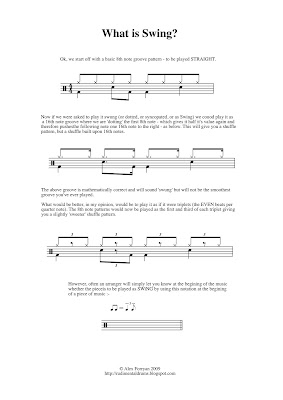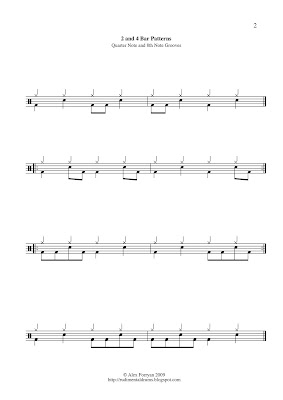Thursday, 7 July 2011
Saturday, 5 February 2011
Friday, 4 February 2011
Saturday, 7 November 2009
Week 8 2nd - 5th November 2009
Firstly, welcome back after our week off for half term. This term, running up to Christmas (and the Christmas Concert on the 20th of December - more on that later!) promises to be very busy and packed full of new and exciting lessons for you all.
This week we looked at playing Jazz and dropping some 'Be-Bop Bombs' on the snare drum.
Work through the sheets below, as we did in class - but remember with Jazz Drumming LESS IS MORE - you DO need to be able to play them all but NEVER put them all in one bar.
This week we looked at playing Jazz and dropping some 'Be-Bop Bombs' on the snare drum.
Work through the sheets below, as we did in class - but remember with Jazz Drumming LESS IS MORE - you DO need to be able to play them all but NEVER put them all in one bar.
Wednesday, 28 October 2009
Week 7 19th - 22nd October 2009
The best fills you"ll ever play ......
All of these fills are based on the standard 16 16th note fill - 1-E-and-a, 2-E-and-a, 3-E-and-a, 4-E-and-a. Try to play a few bars of an 8th note groove before launching into the fill - remember to make sure the tempos match. The 'numbers' and the 'ands' in the groove are the same as in the fill.
All of these fills are based on the standard 16 16th note fill - 1-E-and-a, 2-E-and-a, 3-E-and-a, 4-E-and-a. Try to play a few bars of an 8th note groove before launching into the fill - remember to make sure the tempos match. The 'numbers' and the 'ands' in the groove are the same as in the fill.
Saturday, 17 October 2009
Week 6 12th - 15th October 2009
6 Weeks already! Again apologies for not posting up everything from last week, I'll try to cover everything in this post but if anything gets left out do let me know.
Firstly, 16th note triplets and 16th note triplet shuffle. With regular 16th notes, we would sub-divide each quarter note pulse into 4 beats and count it 1-E-and-a, 2-E-and-a etc. With 16th note triplets we are dividing each beat into 6 even beats with a count of 1-2-3-4-5-6, 2-2-3-4-5-6 etc. To play a shuffle but in 16th note triplet form we would play the pattern like this :- (Bold = notes to be played)
Firstly, 16th note triplets and 16th note triplet shuffle. With regular 16th notes, we would sub-divide each quarter note pulse into 4 beats and count it 1-E-and-a, 2-E-and-a etc. With 16th note triplets we are dividing each beat into 6 even beats with a count of 1-2-3-4-5-6, 2-2-3-4-5-6 etc. To play a shuffle but in 16th note triplet form we would play the pattern like this :- (Bold = notes to be played)
1-2-3-4-5-6 2-2-3-4-5-6 3-2-3-4-5-6 4-2-3-4-5-6
The best exponent of this style of playing is a drummer called Bernard Purdie. He has worked with many recording artists such as Aretha Franklin and Steely Dan. His version of this groove is now well known as the 'Purdie Shuffle' which incorporates 'ghost' notes played on the snare drum with your following hand (example below) as well as a back beat. This can be heard on 'Home at Last' and 'Babylon Sisters' by Steely Dan. This idea was taken even further by another drummer called Jeff Porcaro who often played this groove pattern over 2 bars incorporating a 'clave' pattern on the bass drum - examples of this groove can be found on 'Rosanna' by Toto and 'Any Foolish Thing' by Micheal MacDonald.
An example of this groove can be found at the bottom of this post.
An example of this groove can be found at the bottom of this post.
Our second subject was 8th and 16th note grooves played one-handed and hand-to-hand on the hi hat - with 8th and 16th notes on the bass drum.
The first pattern we played was the 1 and-a, 2 and-a, 3 and-a, 4 and-a, on the hi hat with on hand as show here or hand-to-hand as shown here.
The second pattern was 1-E-and, 2-E-and, etc on the hi hat again played with one hand as shown here or hand-to-hand as shown here.
The third pattern (the one you didn't like!) was playing 1-E a, 2-E a, 3-E a, 4-E a on the hi hat with one hand as shown here and hand-to-hand as shown as here.
The Purdie Shuffle :-
The first pattern we played was the 1 and-a, 2 and-a, 3 and-a, 4 and-a, on the hi hat with on hand as show here or hand-to-hand as shown here.
The second pattern was 1-E-and, 2-E-and, etc on the hi hat again played with one hand as shown here or hand-to-hand as shown here.
The third pattern (the one you didn't like!) was playing 1-E a, 2-E a, 3-E a, 4-E a on the hi hat with one hand as shown here and hand-to-hand as shown as here.
The Purdie Shuffle :-
Friday, 9 October 2009
Week 5 : 5th - 9th October 2009
Again two topics were covered this week, but I think it's worth everyone having a look at the 16th notes under 8th note groove exercises below.
Friday, 2 October 2009
Week 4 : 28th Sept - 1st Oct 2009
Swing is the thing this week!
This week we looked at playing in a swing style - taking a straight groove and applying some basic principles to play it in a more swung, jazzy, blues-ie, funky way.
The first two sheets below cover all that we discussed in class - how you have two options when it comes to changing what you play to make it swing. Option 1 is to 'dot' the first played note, which adds half it's value to itself to make it 'last' longer. Now for us drummers that doesn't mean a great deal but it does mean that the next note that you'll play will be 'pushed' slightly to the right, closer to the next note, which in turn will be dotted an so on. This will give you that 'shuffle' feel that you hear in Jazz and Blues. Option 2 essentially does that same thing but this time you're going to change those straight hi hat beats to triplets with the middle one missing.
Work through the two sheets making sure you're OK with the concept then have a go at the sheet below.
This week we looked at playing in a swing style - taking a straight groove and applying some basic principles to play it in a more swung, jazzy, blues-ie, funky way.
The first two sheets below cover all that we discussed in class - how you have two options when it comes to changing what you play to make it swing. Option 1 is to 'dot' the first played note, which adds half it's value to itself to make it 'last' longer. Now for us drummers that doesn't mean a great deal but it does mean that the next note that you'll play will be 'pushed' slightly to the right, closer to the next note, which in turn will be dotted an so on. This will give you that 'shuffle' feel that you hear in Jazz and Blues. Option 2 essentially does that same thing but this time you're going to change those straight hi hat beats to triplets with the middle one missing.
Work through the two sheets making sure you're OK with the concept then have a go at the sheet below.
Saturday, 26 September 2009
Week 3 : 21st - 24th September 2009
This week's lessons were split between two ends of the same subject, bass drum placement within a groove.
Some classes were doing ALL of the 8th Note and Quarter Note grooves, working between the 8th Note and Quarter Note versions of the same grooves, paying attention to where the bass drum beats fall once the 'ands' have been removed in the Quarter Note version.
Below are a few exercises to work through in your own time. I've written then over 2 and 4 bar sections to get you used to reading multiple bars.
Other classes were introduced to my technique of using the 'up' part of your hi hat stroke to identify where the 16th notes fall in between the 8th notes on the hi hat. This then lead into playing the same patterns but in a more relaxed, laid-back 'swing' style. Below is an exercise demonstrating what we worked on and how the same groove can be written and played three separate ways.
Tuesday and Wednesday Classes
Monday and Thursday Classes
Some classes were doing ALL of the 8th Note and Quarter Note grooves, working between the 8th Note and Quarter Note versions of the same grooves, paying attention to where the bass drum beats fall once the 'ands' have been removed in the Quarter Note version.
Below are a few exercises to work through in your own time. I've written then over 2 and 4 bar sections to get you used to reading multiple bars.
Other classes were introduced to my technique of using the 'up' part of your hi hat stroke to identify where the 16th notes fall in between the 8th notes on the hi hat. This then lead into playing the same patterns but in a more relaxed, laid-back 'swing' style. Below is an exercise demonstrating what we worked on and how the same groove can be written and played three separate ways.
Tuesday and Wednesday Classes
Monday and Thursday Classes
Subscribe to:
Posts (Atom)
















